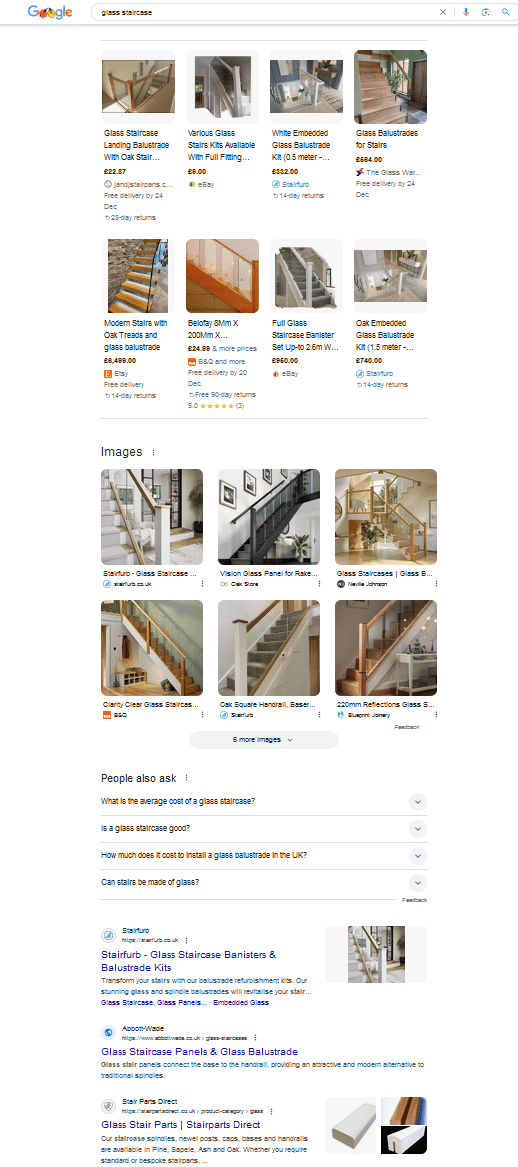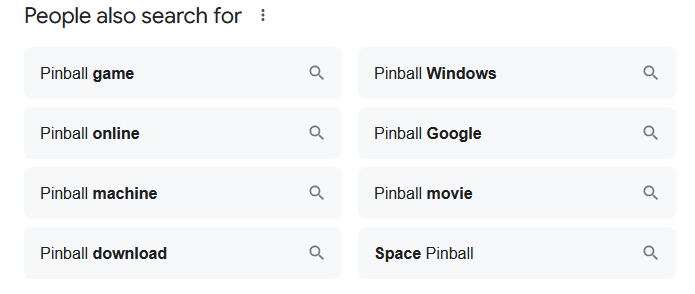
SEO today is about owning as much real estate as possible across a constantly evolving search landscape.
As AI reshapes search results into complex, multi-dimensional experiences, understanding and optimizing for SERP features has become critical.
This article breaks down how brands can adapt to these changes and thrive by leveraging every opportunity for visibility in 2025 and beyond.
Beyond rankings: Mastering SERP visibility
The guiding purpose of SEO is to drive more relevant exposure and traffic to grow your business.
Conventional wisdom suggests achieving this by ranking as high as possible on the page, maximizing the chance of getting clicks.
However, modern search results are far more complex than the simple 10 blue links of the past.
As Google integrates AI into search through 2025 and beyond, results will become increasingly personalized and multi-dimensional.
Today, people browse in diverse ways, and every feature on a results page must serve a purpose – or risk being removed.
When building an SEO strategy and SEO action plan, it’s crucial to consider not only traditional rankings but also every SERP feature relevant to your target keywords.
The goal of modern SEO is twofold:
- Appear as prominently on the page as possible.
- Maximize visibility across multiple on-page elements (SERP features).
As search evolves, so too must SEO strategies to remain effective in this dynamic landscape.
Dig deeper: How to analyze Google’s SERPs
Google search results in 2025 and beyond
SEO results today include classic listings (blue links) and many SERP features that provide search engine users with new ways to discover and browse content.
Semrush sensor data shows that 99% of SERPs feature some SERP features.
This is not a fringe feature. If you are not considering SERP features, you are already falling behind.
There are many SERP features, some very specific to the query intent with low overall exposure (like flights and recipes, for instance), but the most common features are detailed below.
- 93% related searches.
- 72% sitelinks.
- 57% “People also ask” (PAA).
- 55% reviews.
- 50% images.
- 20% knowledge panel.
- 18% local pack .
- 18% video.
- 15% products.
- 7% AI Overviews.
- 4% featured snippet.
- 4% top stories.
- 1% carousel.
This data offers valuable insights into user behavior and the features that engage search engine users. For example:
- The prevalence of related searches indicates their relevance in helping users refine their queries.
- Site links provide more granular entry points into a site.
Prominent features like reviews, “People Also Ask” boxes, and images present significant opportunities for savvy search marketers.
Even less frequent features may be highly relevant within your keyword universe. For ecommerce sites, many targeted search terms likely include organic product listings.
The key is understanding the frequency and relevance of SERP features within your focus topics and optimizing accordingly.
Examples of blended SERPs
Below are interesting examples from recent projects and some of my own browsing.
Example: ‘glass staircase’
We can see the SERP here breaks down as follows:
- 4x text ads.
- 8x shopping (organic).
- 6x images.
- 4x “People also ask.”
- 9x organic (blue links).
- 16x shopping (organic).
- 3x people also buy from.
- 8x organic shopping.
- 1x text ad.
- 6x “People also search for.”

This page is packed with features, including a block of organic listings with images, highlighting the importance of visuals for this search.

And because the search query has a high commercial intent, we also see shopping listings.
The key point is that the first traditional organic listing appears as the 19th result on the page, and when accounting for up to 8 shopping or text ads, it’s closer to the 27th option.
Example: ‘pinball’
The SERP breaks down here a little differently, and we see:
- 5x shopping ads.
- 3x organic.
- 3x images.
- 4x “People also ask.”
- 8x shopping.
- 6x organic.
- 8x “People also search for.”
This example is less commercial and includes a mix of results, such as:
- Various types of pinball games.
- A Wikipedia entry.
- Online pinball games.
- Pinball mages.
- Related questions.
- Lower-priced home pinball options.
- Even a local pinball bar.
The People also search for results offer insight into the intent behind a broad search like “pinball,” showing users’ likely shift toward digital games and apps rather than actual pinball machines.

It’s also worth noting that, since I’m in the UK, pinball is less popular here than in other countries, which is reflected in the results.
This mixed set of results suggests that the search is part of the user’s journey, likely to be refined further toward specific intent, such as digital games or pinball tables for sale.
Ranking for multiple SERP features
In addition to common SEO KPIs, a key goal for SEO in 2025 should be maximizing visibility across the entire page of search results.
If you’re already visible in the standard organic results, boosting your presence across multiple features on the same page can be relatively simple.
The key is understanding the results for your most valuable keywords.
The following process will outline how to identify and optimize for each SERP feature.
3 steps for optimizing visibility across different SERP features
The SAO (search, analyze, optimize) process is a simple approach to boosting exposure across various SERP features on Google and other search engines.
Search: The humble keyword
Identify relevant keywords. You can use your preferred keyword research strategy or pull them from existing research, rank reports, or PPC data (especially if you have conversion data).
Google Search Console can also offer insights for easy wins.
You can organize your keywords using this document template:
Analyze: Map the SERP layout
For each keyword, identify the relevant SERP features and update the template to guide your optimization efforts.
Optimize: Increase visibility
With an understanding of the prominence of other SERP features, you can now focus on boosting your exposure.
SERP feature optimization tips
Optimizing for SERP features requires tailoring your strategy to the features most relevant to your goals.
While this article doesn’t cover every SERP feature, here are actionable tips for tackling the most prominent ones.
Related searches
- Integrate semantically related keywords and phrases into your content to align with potential related searches.
- Track these searches for your primary keywords, optimizing existing content or creating new material to target them effectively.
- Seamlessly align your content marketing and SEO to maximize visibility for these terms.
Sitelinks
- Ensure your site has a clear, logical structure with descriptive headings, subheadings, and strong internal linking.
- This helps Google understand the relationships and importance of your key pages, making your site more likely to generate sitelinks.
‘People also ask’
- Analyze SERPs to identify common questions related to your target keywords.
- Create FAQ content with concise, informative answers to increase your chances of appearing in PAA boxes.
Reviews
- Use review schema markup on product or service pages to display star ratings in search results.
- Encourage satisfied customers to leave positive reviews.
- Leverage both aggregated and single reviews to enhance credibility.
Images
- Optimize image file names, alt text, and relevance to your content.
- Create image sitemaps to help Google index them effectively.
- Incorporate SEO planning into your site’s structure to provide clear contextual relevance for images.
Knowledge panel
- Maintain accurate, consistent information about your business across authoritative sources.
- Claim and optimize your Google Business Profile (GBP), and use structured data to provide clear details about your entity.
Local pack
- Keep your GBP listing updated with accurate information, including your address, phone number, and hours.
- Incorporate local keywords into your website, encourage customer reviews, and post regular updates to drive engagement.
Video
- Create high-quality, relevant videos, host them on platforms like YouTube, and optimize titles, descriptions, and tags with target keywords.
- Embed videos on your site to enhance visibility.
- If video content is absent from SERPs, capitalize on first-mover advantage by creating and optimizing video content. The SCAMPER framework can help you create new forms of existing content to simplify planning new video content.
Products
- Use product schema markup to provide detailed product information in search results.
- Ensure titles, descriptions, and prices are accurate and current.
- Submit product feeds and variants to Google Merchant Center for better visibility.
AI Overviews
- Focus on creating comprehensive, well-structured content that directly answers user queries.
- Ranking highly for target terms increases the likelihood of inclusion in AI Overview listings.
- Use the value proposition framework to create superior content that stands out.
Featured snippet
- Structure your content to directly answer specific questions, using concise language, lists, tables, or bullet points to match featured snippet formats.
- Prioritize accuracy and clarity, and optimize pages to rank highly for your target queries.
Top stories
- Publish timely, newsworthy content.
- Ensure your site is recognized as a news source by Google.
- Implement article schema markup and submit a news sitemap to improve indexing.
Carousel
- Create a series of related content pieces with appropriate schema markup to indicate their relationship, enabling them to appear in carousel formats.
Tailor your approach to the SERP features that matter most to your goals.
While there are many SERP features, understanding their requirements and aligning your strategy is key to maximizing visibility and engagement.
Strategy vs. tactics: A final tip
When working to maximize exposure for the keywords that matter to your business, it’s important to recognize the interplay between strategy and tactics.
Sometimes, achieving greater visibility requires not just SEO adjustments but also a reevaluation of your product strategy.
For example:
Staircase kits
- A company selling bespoke staircase kits found their SERPs dominated by inexpensive DIY kits featured in shopping ads and organic listings.
- To compete, they introduced simple, affordable kits as a “trojan horse” strategy, using these to boost visibility and upsell customers to their fully bespoke solutions.
Premium artificial grass
- A business offering high-end artificial grass faced a similar challenge, as search results were dominated by far cheaper alternatives.
- To maintain visibility, they introduced lower-cost products to increase sample requests and used this opportunity to educate customers on the benefits of upgrading to premium options.
Adjustments to product offerings were key to improving search visibility in both cases.
SEO isn’t just a standalone tactic. It can provide valuable insights into your broader product strategy, creating a feedback loop that enhances visibility and drives better results.
source https://searchengineland.com/how-to-maximize-visibility-on-googles-blended-serps-449450


0 Comments